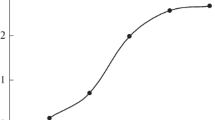Summary
The osmium catalysis of the Ce(IV)-As(III) reaction is made the basis of a general method for the determination of 0.001 to 0.2μg Os per milliliter. The rate of reaction can be determined photometrically or potentiometrically.
Osmium is isolated by extraction of the tetroxide with chloroform or carbon tetrachloride, and returned to aqueous medium by shaking with arsenious acid-sulfuric acid solution which is then treated with eeric ammonium sulfate to effect the final determination. Ruthenium which is also a strong positive catalyst for the Ce(IV)-As(III) reaction will be kept in reduced form and will not be extracted by the organic solvents if the solution of Os(VIII) and Ru(VIII) is treated with a slight excess of ferrous iron and then with nitric acid to make its concentration about 5M. Iodine, the other strong catalyst for the reaction, can be inactivated by silver ion. Osmium recoveries of 90 per cent or better can be obtained from solutions containing as little as 0.0002 p. p. m. Os.
The kinetics of the osmium catalyzed ceric-arsenious reaction has been investigated. The rate is independent of the Ce(IV) concentration but is a function of the As(III) concentration. The slow step in the catalyzed reaction is therefore the reduction of Os(VIII) by As(III).
Zusammenfassung
Die Katalyse der Reaktion zwischen Ce(IV) und As(III) durch Osmium dient als Grundlage der Bestimmung des letzteren in Lösungen, die 0,001 bis 0,2μg Osmium im Milliliter enthalten. Die Reaktionsgeschwindigkeit kann photometrisch oder potentiometrisch bestimmt werden.
Das Osmium wird als Tetroxyd mit Chloroform oder Tetrachlorkohlenstoff extrahiert. Beim Schütteln dieses Extraktes mit schwefelsaurer Lösung von arseniger Säure geht Osmiumtetroxyd in die wässerige Phase über und wird zum Zweck der quantitativen Bestimmung mit Ceriammoniumsulfat behandelt. Ruthenium, das die Reaktion beeinflußt, wird in der ursprünglichen Lösung zurückgehalten, indem man diese vor Extraktion mit dem organischen Lösungsmittel mit Ferroammoniumsulfat und Salpetersäure behandelt. Jodid, das ebenfalls die Reaktion stark beschleunigt, wird durch Zugabe von Silbersulfat unschädlich gemacht. Aus 2∶1010 verdünnten Lösungen kann auf diese Weise das Osmium zu 90% und mehr wiedergefunden werden.
Die Kinetik der katalysierten Reaktion wurde untersucht. Die Reaktionsgeschwindigkeit ist eine Funktion der As(III)-Konzentration und unabhängig von der Ce(IV)-Konzentration. Die langsame Teilreaktion ist daher die Reduktion von Os(VIII) durch As(III).
Résumé
La catalyse par l'osmium de la réaction Ce(IV)-As(III) est à la base d'une méthode générale pour le dosage de 0,001 à 0,2μg d'osmium par ml. La vitesse de réaction peut être déterminée photométriquement ou potentiométriquement. L'osmium est isolé en extrayant le tétroxyde par le chloroforme ou le tétrachlorure de carbone et remis en milieu aqueux par agitation avec la solution acide arsénieux-acide sulfurique qui est alors traitée par le sulfate cérique ammoniacal pour produire le dosage final. Le ruthénium qui est aussi un catalyseur fortement positif pour la réaction Ce(IV)-As(III) sera maintenu sous la forme réduite et ne sera pas extrait par les dissolvants organiques si la solution Os(VIII) et Ru(VIII) est traitée par un léger excès de fer ferreux puis avec l'acide nitrique pour rendre sa concentration environ 5 M. L'iode, autre catalyseur positif puissant pour la réaction peut être rendu inactif par l'ion argent. A partir de solutions ne contenant que 0,0002 p. p. m. d'osmium on peut en récupérer mieux que 90%.
La cinétique de la réaction cérium-arsenic catalysée par l'osmium a été soumise à l'expérience. La vitesse est indépendante de la concentration en Ce(IV) mais c'est une fonction de la concentration en As(III). Le palier lent de la réaction catalysée est par conséquent la réduction de Os(VIII) par As(III).
Similar content being viewed by others
Literature
J. J. Ivan, unpublished work, University of Minnesota, 1940.
T. Shiokawa, J. Chem. Soc. Japan, Pure Chem. Sect.70, 314, 316, 353, 355 (1949).
A. Lein andN. Schwartz, Analyt. Chemistry23, 1507 (1951).
R. D. Sauerbrunn andE. B. Sandell, Analyt. Chim. Acta (1953).
Author information
Authors and Affiliations
Additional information
From a portion of the Ph. D. thesis ofR. D. Sauerbrunn, 1952.
Rights and permissions
About this article
Cite this article
Sauerbrunn, R.D., Sandell, E.B. Determination of submicrogram quantities of osmium by catalysis. Mikrochim Acta 41, 22–33 (1953). https://doi.org/10.1007/BF01215763
Received:
Issue Date:
DOI: https://doi.org/10.1007/BF01215763



